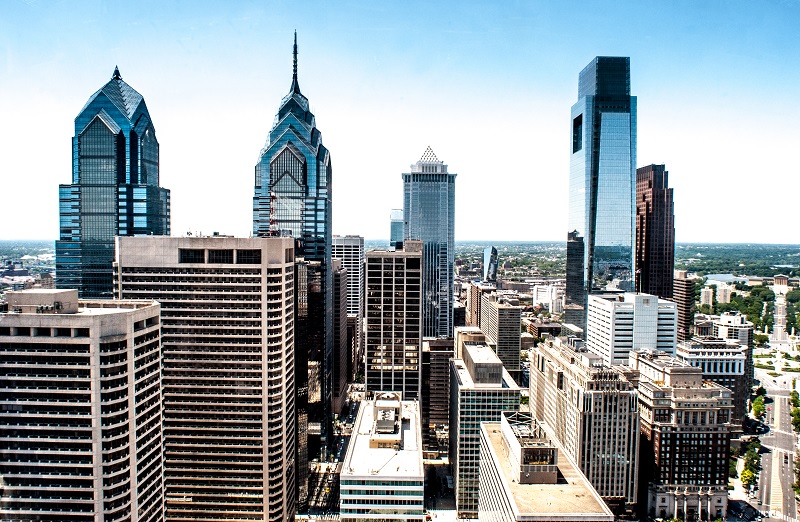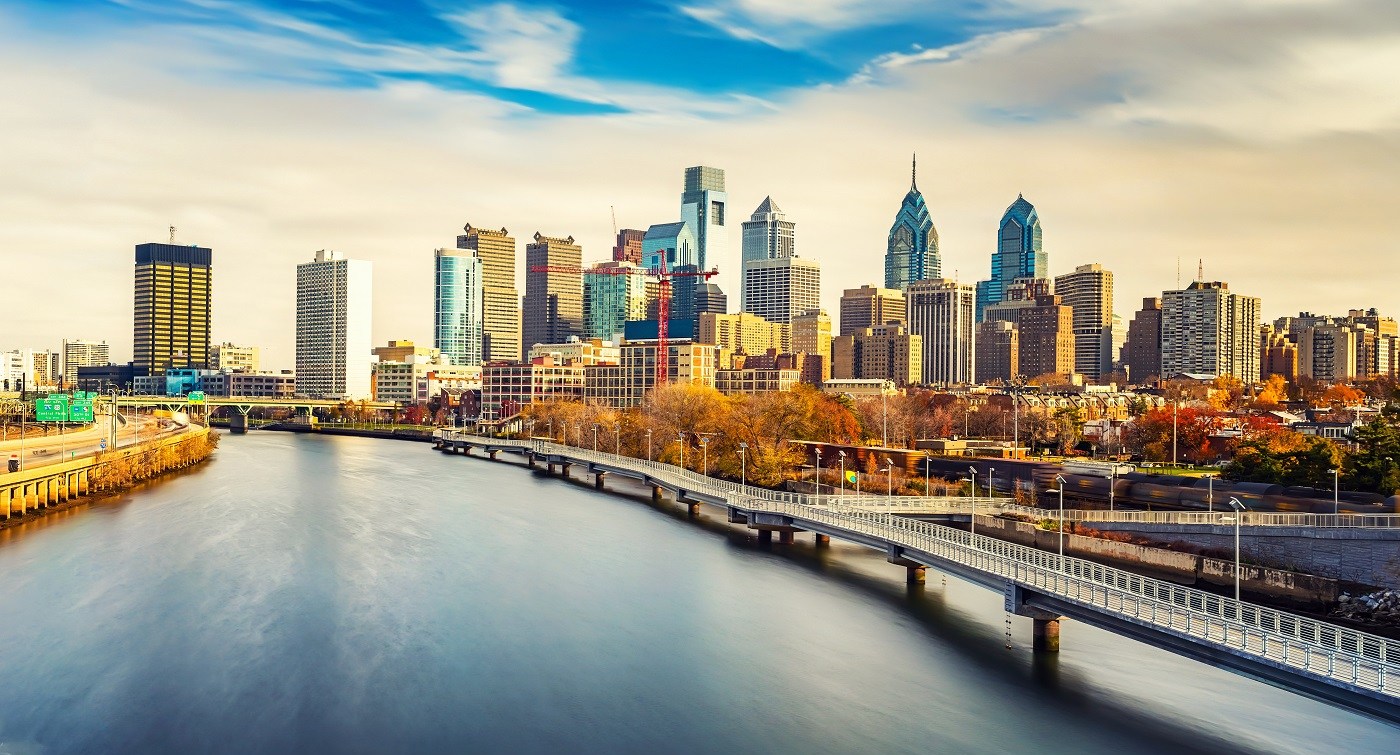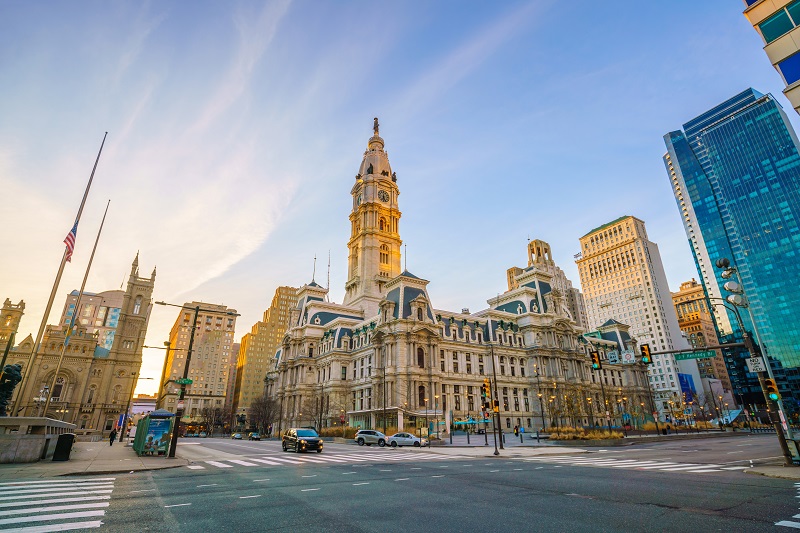Though it’s home to fewer record-breaking skyscrapers than other cities with similar skylines, Philadelphia has always pushed the boundaries of design and architecture with every new major development. One year from now, that skyline will reach new heights with the completion of the 60-story Comcast Technology Center, set to be the tallest building in the city and in all of Pennsylvania, as well as the tallest structure in the country outside of New York and Chicago. Add to that the proposed Schuylkill Yards project, a $3.5 billion mixed-use development that broke ground in late 2016, and it’s safe to say that the City of Brotherly Love is in the midst of a new building boom.
Philadelphia apartments, offices, hotels, and business centers will increase in number, and as the city prepares for these changes, we thought it’d be interesting to see how its skyline evolved throughout the decades, from its very first skyscraper to its latest. Watch below our video mapping out the evolution of downtown Philadelphia and its 100 tallest buildings, and read on to find out more about the most notable projects.
Philly’s Early Skyscrapers – From Churches to Office Buildings
The Philadelphia skyline began to take shape way back in 1753, with the construction of the Independence Hall at 520 Chestnut St. Designed by local architect William Strickland in the Georgian style of architecture, Independence Hall was the birthplace of the United States Declaration of Independence, signed at the site on July 4th, 1776, as well as the United States Constitution, ratified in 1788. The Hall was the city’s tallest structure for a mere six years, surpassed by the Christ Church in 1754. The Episcopal church served as the city’s tallest building for 102 years, and its 196-foot tower and steeple was the tallest structure in North America from 1754 to 1810. The next to reign over the Philly skyline was another church–the Tenth Presbyterian Church at 17th and Spruce Streets was the city’s tallest building from 1856 to 1900.
It wasn’t until 1900 that an office building took the crown as Philadelphia’s tallest building. The North American Building at 121 S. Broad St. snatched that title away from the Tenth Presbyterian Church when it topped out at 21 stories and 266 feet, designed in the familiar Chicago school style of architecture. Nonetheless, the brick-clad building commissioned by Thomas B. Wanamaker (son of John Wanamaker, founder of the Wanamaker’s department store) was surpassed by the iconic Philadelphia City Hall just one year later.
Philadelphia’s architecture ticked off further milestones during the early 1930s, the most notable being the introduction of the first International-style skyscraper in the U.S. The PSFS Building, now the Loews Philadelphia Hotel, was built in 1932 for the Philadelphia Savings Fund Society and designed by William Lescaze and George Howe. The 36-story tower at 1200 Market St. was converted into hotel space and the Loews Philadelphia Hotel opened its doors to guests in time for the 2000 Republican National Convention. Another important architectural landmark built in the 1930s is One South Broad, formerly known as the Lincoln-Liberty Building or the PNB Building. The 28-story Art deco office tower is located in Center City and used to house Wanamaker’s Men’s Store, until it was acquired by the Philadelphia National Bank in 1952.
City Hall Takes the Reins in 1901, Under William Penn’s Watchful Eye
An important milestone in the development of downtown Philadelphia was the 1901 completion of the City Hall, at 1 Penn Square. Topping off at 548 feet, it was designed to be the world’s tallest building, but was surpassed during construction by the Eiffel Tower and the Washington Monument. Philly’s seat of government did, however, tower as the tallest structure in the city for 86 years, and remains the largest municipal building in the world (larger than the U.S. Capitol) and a U.S. National Historic Landmark. Its most recognizable feature is the 37-foot bronze statue of city founder William Penn, the tallest statue atop any building in the world. England-born Penn is regarded as the founder of the Province of Pennsylvania and an avid militant for democracy and religious freedom. The democratic principles set by Penn in the Pennsylvania Frame of Government paved the way for the development of the United States Constitution.
The Rise of Liberty Place and the Curse of Billy Penn
For more than eight decades, there was a standing ‘gentleman’s agreement’ among developers that no building in the city should be taller than the statue of William Penn atop the Philadelphia City Hall. That agreement ended in 1987 with the construction of One Liberty Place, the first building in 86 years to exceed the height reached by the iconic statue. The 61-story, 945-foot office building was controversial from the get-go, but the project was finally approved because of the large number of jobs it would create in the city. One Liberty Place held the title of Philadelphia’s tallest building for 21 years, until the completion of the Comcast Center in 2008. The second phase of the project was completed in 1990, with the build-out of the 58-story Two Liberty Place. The mixed-use complex also includes the Shops at Liberty Place and the 14-story Westin Philadelphia Hotel.

Left to right: Two Liberty Place, One Liberty Place, BNY Mellon Center and the Comcast Center (Shutterstock)
Yet One Liberty Place is said to have brought a curse upon the city, namely the ‘curse of Billy Penn.’ Legend has it that major professional sports teams in the city failed to win any championships because One Liberty Place broke the agreement and surpassed the statue of Philadelphia city founder William ‘Billy’ Penn. From then on, local sports teams experienced a series of major loses, like the Philadelphia Flyers losing the Stanley Cup Finals twice, the Phillies losing the 1993 World Series, the Philadelphia 76ers losing the 2001 NBA Finals and the Philadelphia Eagles losing three NFC Championship games in a row. The curse is said to have been lifted in 2007, when the Comcast Center topped off in downtown Philadelphia. Construction workers installed a small statue of William Penn to the final beam, in an attempt to end the 20-year curse.
More Skyscrapers Crowd the Philadelphia Skyline in the ’90s
After the rise of One Liberty Place broke development barriers, skyscraper construction took off in Philadelphia. The 1990s saw many notable towers pop up on the city skyline, including the Kohn Pederson Fox-designed BNY Mellon Center, which was featured in the 1993 movie Philadelphia, starring Tom Hanks. Currently the fifth-tallest building in the city, rising 54 stories above ground, the BNY Mellon Center at 1735 Market St. is part of the Penn Center office and retail complex located right in the heart of the central business district.
Center City is home to another notable office development to reach completion during the early 1990s. In 1985, construction began on Commerce Square, a two-building office complex at 2001-2005 W. Market St. One Commerce Square was completed in 1987, while the second tower was finalized in 1990. The 41-story twin towers were designed by I.M. Pei & Partners, and their build-out concluded the office construction boom of the decade in Philadelphia. One and Two Commerce Square were the last office skyscrapers to rise in the city until the development of the Cira Centre in 2005.
Comcast Steals the Philly Spotlight–Twice
After ruling the land as Philadelphia’s tallest building for 21 years, One Liberty Place finally gave up that title in 2008, when the 974-foot, 58-story Comcast Center was completed. Designed by world-renowned architect Robert A. M. Stern, Comcast’s Class A+ corporate headquarters is currently the tallest building in Philadelphia and the state of Pennsylvania. Located at 1701 John F. Kennedy Blvd., the 1.2 million-square-foot, LEED Gold-certified high-rise is owned by Liberty Property Trust and cost $540 million to build. The glass-clad tower is also the tallest building in the U.S. outside of New York City and Chicago–a title it won’t hold much longer.
Comcast and Liberty Property Trust have joined forces once more to develop the Comcast Technology Center, currently underway at 1800 Arch St. Upon completion in 2018, the 60-story, 1.6 million-square-foot tower will surpass the Comcast Center as the city’s tallest building. It will include 1.3 million square feet of rentable office space, 230,112 square feet of hotel space, 2,682 square feet of retail, and 14,663 square feet of residential space, according to data gathered by Yardi Matrix. Comcast’s second Philadelphia home is also expected to earn LEED Platinum certification from the USGBC.
Find all of Philadelphia’s 100 tallest buildings on the map below:










